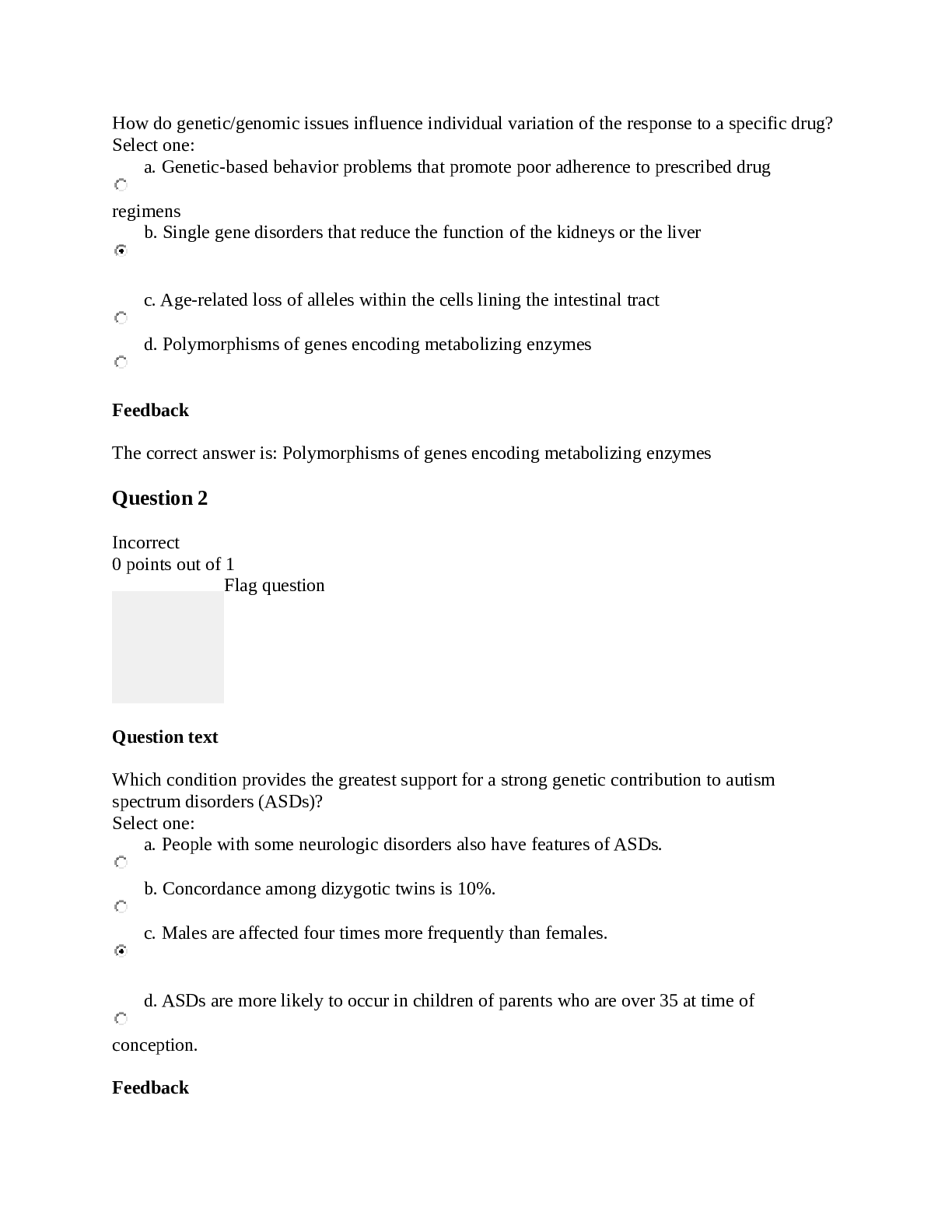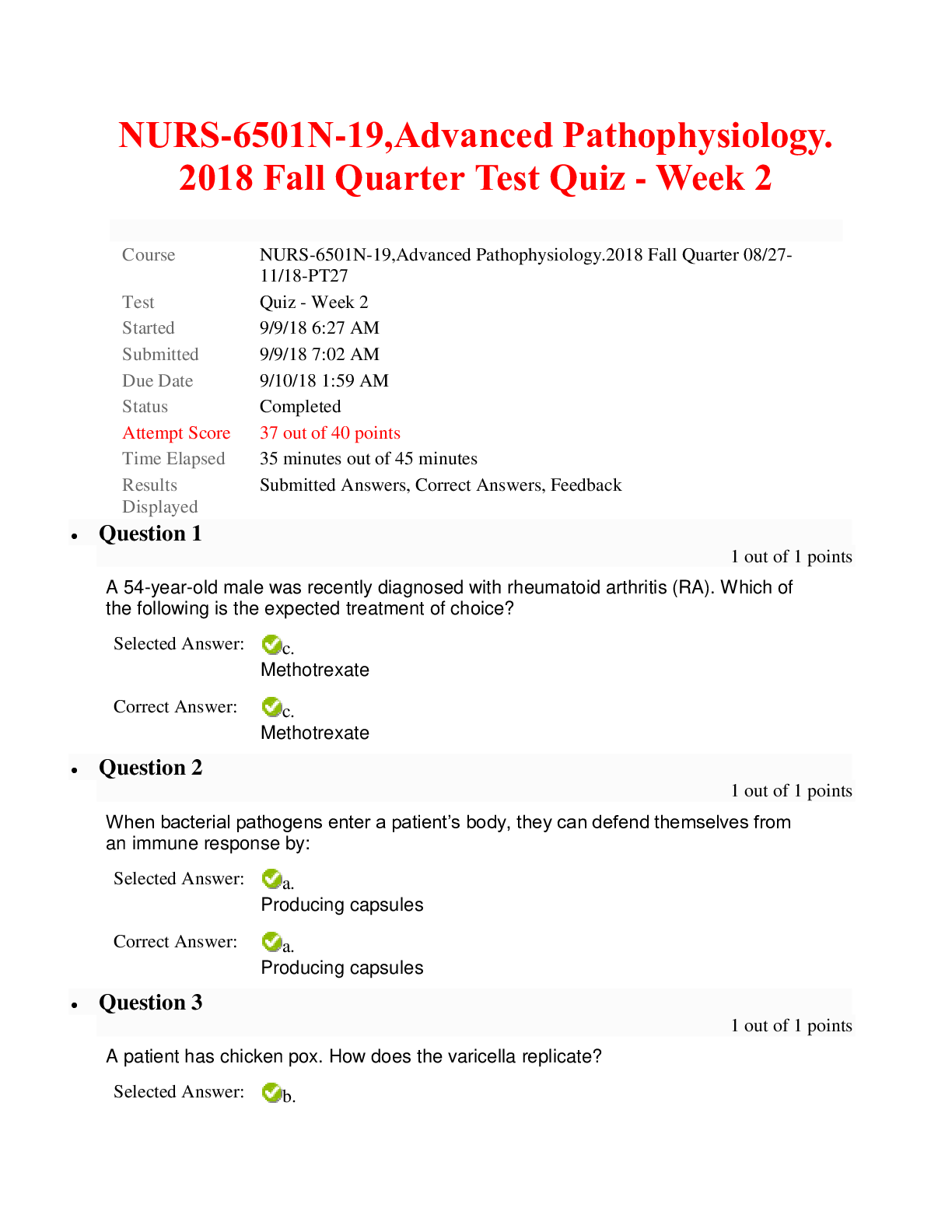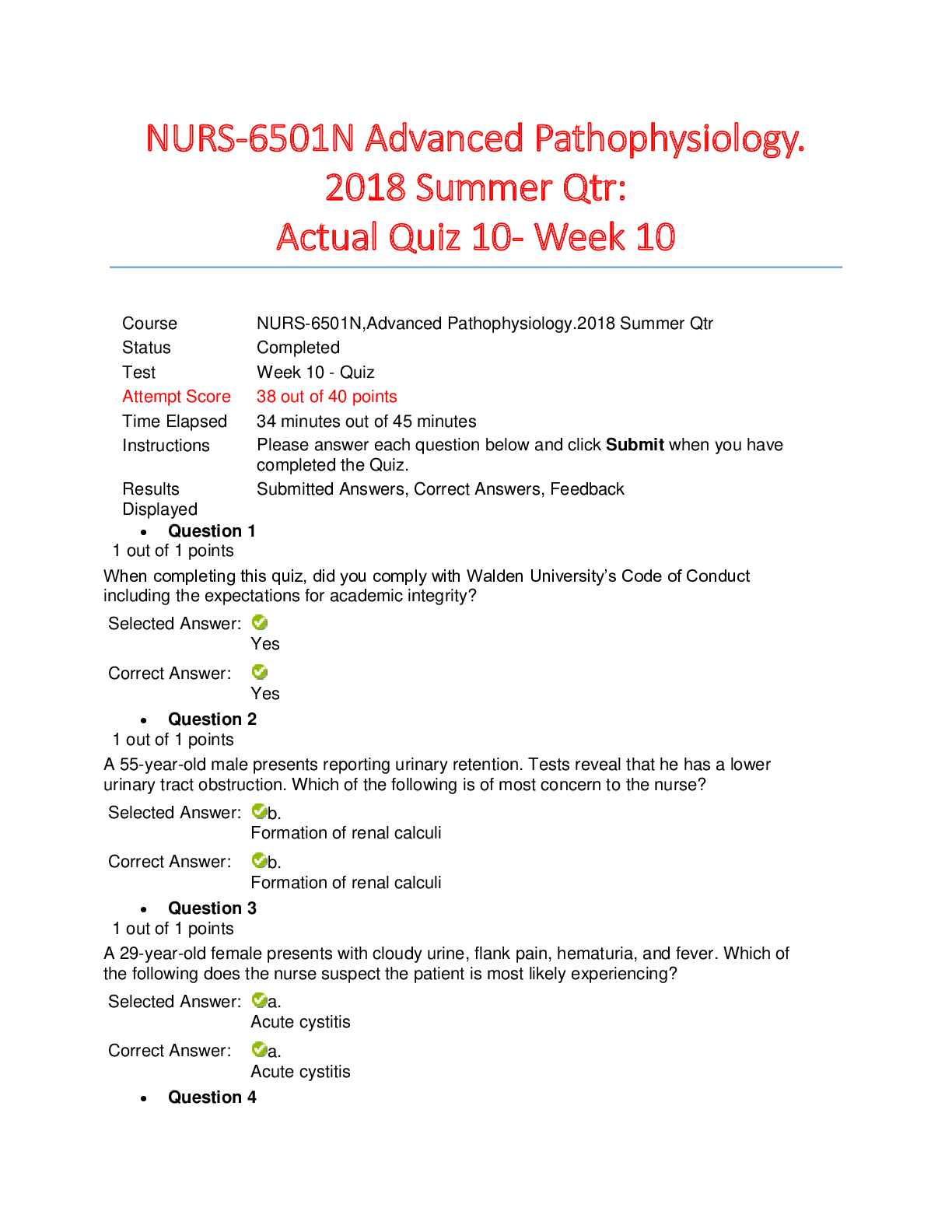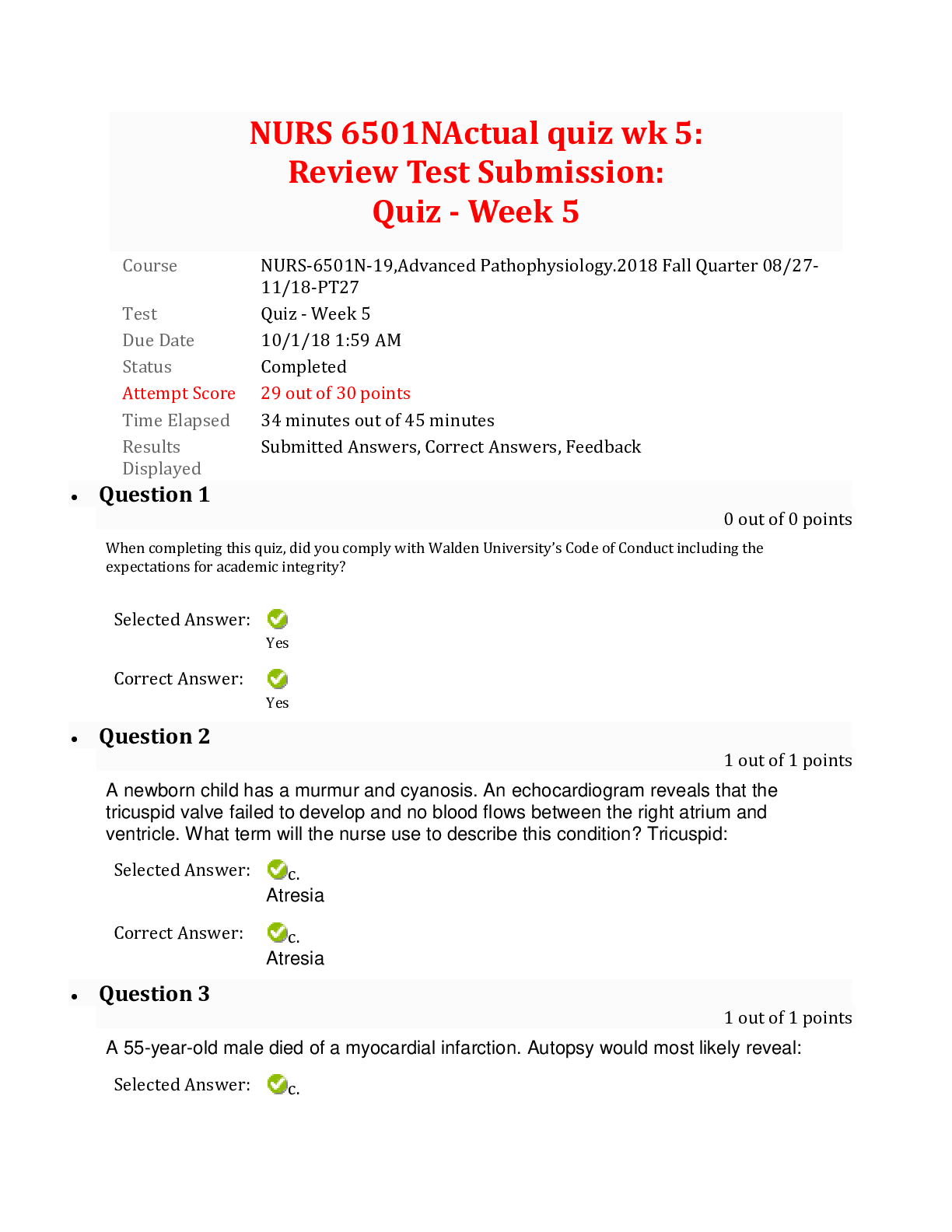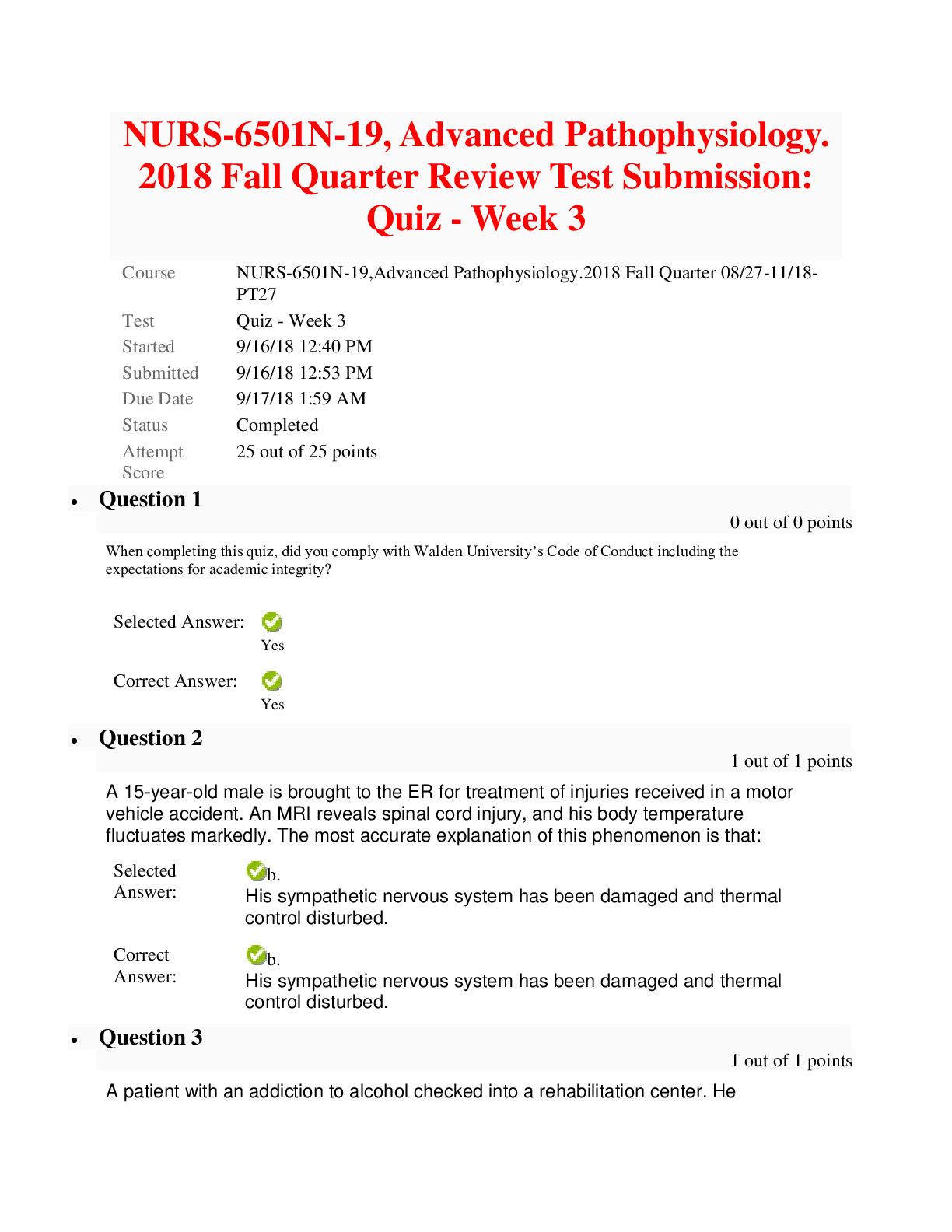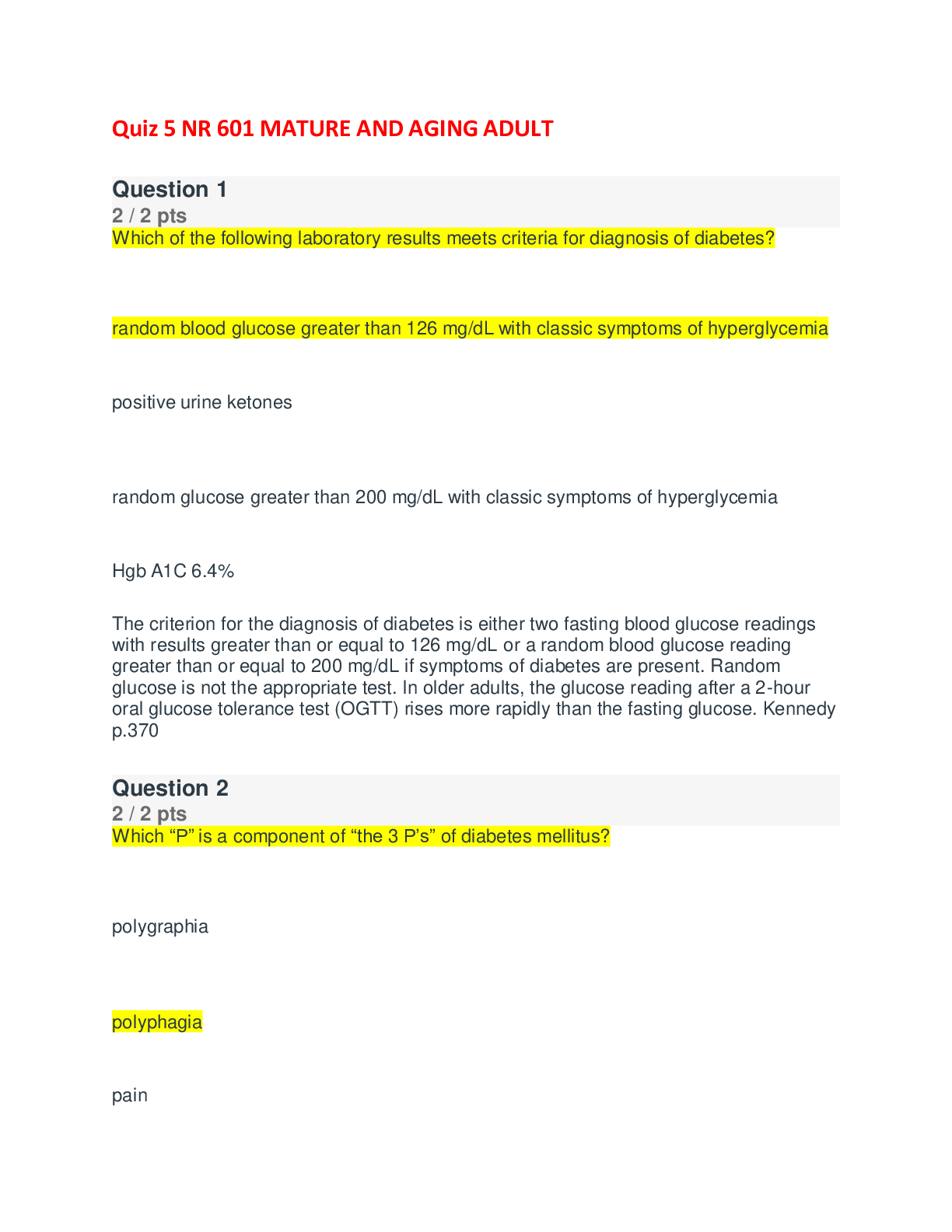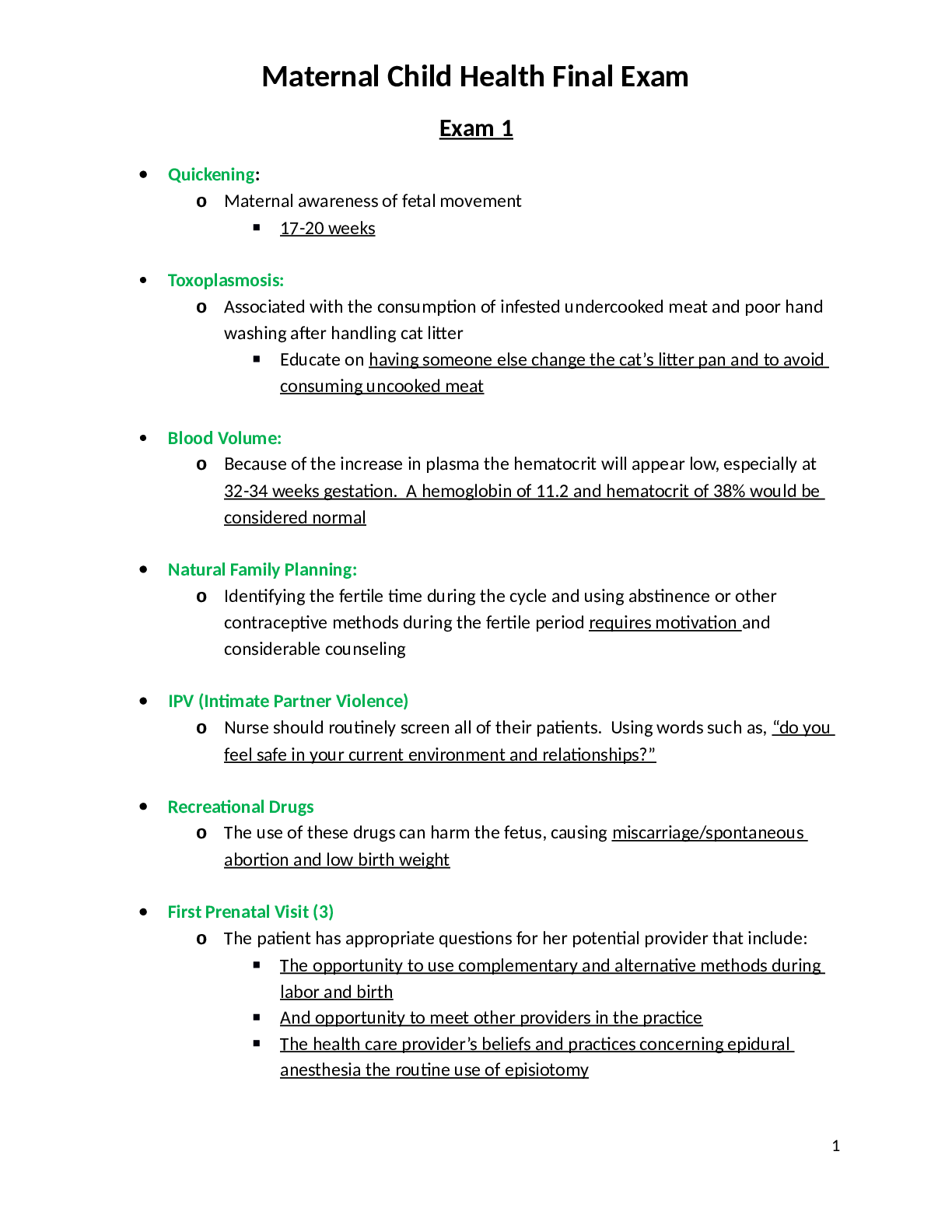*NURSING > QUESTIONS & ANSWERS > AORN PERIOP 101 Exam with 100% Correct Answers. Graded A (All)
AORN PERIOP 101 Exam with 100% Correct Answers. Graded A
Document Content and Description Below
AORN PERIOP 101 Exam with 100% Correct Answers All the following professionals are qualified to provide anesthesia to a patient EXCEPT: a) anesthesiologist b) CRNA c) anesthesiology assistant d)... operating surgeon -Answer- d) operating surgeon Of the following, which is not used to secure airway: a) ET tube b) LMA c) nasal cannula d) oral airway -Answer- c) nasal cannula The perioperative team should know the location of equipment stored in the OR and in the department. Equipment that the anesthesia provider may request includes: a) video laryngoscopy devices b) fiberoptic bronchoscopes c) suction tips and devices d) all of the above -Answer- d) all of the above General Anesthesia -Answer- a drug-induced reversible state of unconsciousness, it includes amnesia, analgesia, loss of responsiveness, decreased stress response, and loss of skeletal muscle reflexes to varying degree Regional Anesthesia -Answer- an injection of local anesthetics near nerve fibers to cause reversible loss of sensation over an area of the body, common examples include spinal, epidural, and peripheral nerve blocks Monitored Anesthesia Care (MAC) -Answer- when an anesthesia provider monitors the patient, administers sedatives and other agents as needed, and provides medical services as needed Moderate Sedation -Answer- the administration of sedative, analgesic, and/or anxiolytic agents by a physician or under physician supervision. Depending on state laws and hospital policies, a perioperative nurse may be able to administer this type of anesthesia Local Anesthesia -Answer- The infiltration or topical administration of agents to anesthetize a part of the body. It is typically used for minor procedures, does not involve an anesthesia provider, and does not involve sedation. A perioperative nurse monitors the patient and provides supportive care if needed. The phases of general anesthesia, in order, are:a) induction, maintenance, emergence b) emergence, maintenance, induction c) maintenance, emergence, induction d) induction, emergence, maintenance -Answer- a) induction, maintenance, emergence Propofol -Answer- IV induction agent etomidate -Answer- IV induction agent methohexitol -Answer- IV induction agent IV induction agent -Answer- ketamine sevoflurane with or without nitric oxide -Answer- inhaled induction agent Succinylcholine -Answer- short-acting muscle relaxant cisatracurium -Answer- intermediate-acting muscle relaxant atracurium -Answer- intermediate-acting muscle relaxant rocuronium -Answer- intermediate-acting muscle relaxant vecuronium -Answer- intermediate-acting muscle relaxant pancuronium -Answer- long-acting muscle relaxant isoflurane -Answer- used for inhalation maintenance desflurane -Answer- used for inhalation maintenance total iv anesthesia (TIVA) -Answer- a technique for maintaining anesthesia using infusions of short-acting IV agents without inhalation anesthetics. Propofol and remifentanil are often used for TIVA. Reversal agent for succinylcholine -Answer- none! neostigmine -Answer- reversal for muscle relaxant (except succinylcholine) edrophonium -Answer- reversal for muscle relaxant (except succinylcholine) sugammadex -Answer- reversal agent for rocuronium, vecuronium, and pancuronium flumazenil -Answer- reversal agent for benzos (midazolam) naloxone -Answer- reversal agent for narcotics (fentanyl)which of the following type of airway maintenance usually requires muscle relazants? a) spontaneous respiration b) mask ventilation c) laryngeal mask airway d) endotracheal intubation -Answer- d) endotracheal intubation When should cricoid pressure be released? a) if the patient coughs b) when the patient loses consciousness c) if the anesthesia provider cannot see the vocal cords d) after the cuff of the ET tube is inflated and the position is confirmed -Answer- d) after the cuff of the ET tube is inflated and the position is confirmed lidocaine -Answer- local anesthetic bupivacaine -Answer- local anesthetic ropivacaine -Answer- local anesthetic tetracaine -Answer- for long-acting spinal anesthesia epinephrine (anesthesia) -Answer- added to increase density and duration of a regional block bicarbonate (anesthesia) -Answer- sometimes added to reduce the acidity of the local anesthetic and speed the onset of the block Spinal Anesthesia -Answer- the subarachnoid space is entered and local anesthetic is injected directly into the spinal canal, pt sitting or lateral Epidural Anesthesia -Answer- the anesthesia care provider finds the space between the ligamentum flavum and dura, this space is identified by a loss of resistance as the needle is advanced, a single dose of anesthetic can be injected, or a catheter can be placed IV regional anesthesia (Bier Block) -Answer- used for procedures on hand, wrist, or forearm (double tourniquet method) Local Anesthetic System Toxicity (LAST) -Answer- can occur if unsafe amount of local anesthetic enters bloodstream, can occur slowly as med is absorbed over time, or quickly if accidentally injected into blood vessel CAN PROGRESS TO SEIZURES AND CARDIAC OR RESP ARREST Symptoms of LAST -Answer- -ringing in ears -tingling lips-metallic taste in mouth -dizziness Sedation can be used with any of the following types of anesthesia except: a) regional anesthesia b) monitored anesthesia care c) general anesthesia d) local anesthesia -Answer- d) local anesthesia Malignant Hyperthermia (MH) -Answer- a rare but potentially life-threatening complication of anesthesia, triggered by inhaled general anesthetic agents and the muscle relaxant succinylcholine Complications of MH -Answer- it can lead to cardiac arrest, brain damage, organ failure, and death increased end-tidal CO2 -Answer- most specific sign of MH Dantrolene -Answer- drug used to treat MH Hypothermia -Answer- a core body temperature <36c (<96.8F) Which of the following is associated with increased risk for hypothermia? a) female sex b) higher than normal body weight c) hyperthyroid d) hypertension -Answer- a) female sex Identify the active warming devices a) circulating water garments b) cotton blankets c) forced-air warming devices d) increased ambient room temperature e) surgical drapes d) warmed IV fluids -Answer- a) circulating water garments c) forced-air warming devices d) increased ambient room temperature f) warmed IV fluids Which of the following would be an appropriate action for the perioperative nurse when assisting with anesthesia? a) administer the muscle relaxant reversal agent if needed? b) apply cricoid pressure if needed during intubation c) document anesthetic agents used, dose, route, and time d) extubate the patient -Answer- b) apply cricoid pressure if needed during intubationWhich of the following is NOT included in basic monitoring of the patient for anesthesia? a) pulse oximetry b) ECG c) arterial line d) blood pressure -Answer- c) arterial line Which drug is used to reverse valium and midazolam? a) neostigmine b) pancuronium c) flumazenil d) succinylcholine -Answer- c) flumazenil Which method is used to prevent aspiration during endotracheal intubation? a) applying cricoid pressure b) inserting a nasal/oral airway c) laryngoscopy d) invasive techniques -Answer- a) applying cricoid pressure How can the perioperative nurse assist the anesthesia provider with placement of a spinal or epidural block? a) inject local anesthetic b) thread the catheter through the needle c) calm the patient d) identify landmarks for insertion of the needle -Answer- c) calm the patient During IV regional anesthesia the tourniquet should be deflated slowly to prevent which of the following from entering the bloodstream? a) bacteria b) lymphatic fluids c) thrombus d) bolus of anestheitc -Answer- d) bolus of anesthetic Depending on state laws and hospital policies, which of the following can be performed without a professional anesthesia provider? a) general anesthesia b) regional anesthesia c) monitored anesthesia care d) moderate sedation -Answer- d) moderate sedation Which assessment factor is important to include when screening patients for MH? a) family history of problems related to anesthesia b) patients age c) patients use of herbal and vitamin supplements d) patients use of OTC meds -Answer- a) family history of problems related to anesthesiaThe RN caring for the patient receiving moderate sedation/analgesia should: a) turn up the monitor alarms when prepping the patient b) be competent in the use of emergency resuscitation procedures c) call an anesthesia provider to administer reversal medications d) all of the above -Answer- b) be competent in the use of emergency resuscitation procedures laparoscopy -Answer- examination of the abdominal cavity or performance of a minor abdominal surgery using a laparoscope endoscopy -Answer- examination by means of an endoscope endoscope -Answer- a tube inserted into a natural body orifice or through a small incision to access internal organ structures, can be flexible, rigid, or semirigid flexible endoscope -Answer- includes cystoscope, laparoscope, sinuscope, arthroscope, and hysteroscope semi-rigid endoscope -Answer- includes a deflectable-tip video laparoscope that will allow movement through the tip to allow a complete view from a variety of different angles operative endoscope -Answer- channeled scopes that provide the ability to irrigate, suction, insert, and connect a variety of accessories capacitive coupling -Answer- transfer of electrical current from the active electrode through intact insulation to adjacent conductive items (tissue, trocars) Based on your knowledge of laparoscopic surgery, identify the potential complications related to it: a) pneumonia b) hypoxemia c) hypercarbia d) cardiac dysrhythmia e) hypocarbia f) CO2 embolism -Answer- b) hypoxemia c) hypercarbia d) cardiac dysrhythmia f) CO2 embolism Which are the major components of medical video imaging? a) electrosurgical unit b) fiber-optic light cable c) verres needle d) camera control unit -Answer- b) fiber-optic light cable d) camera control unitBased on your knowledge of cameras in endoscopic surgery, identify the tasks that should be completed while setting up the camera before surgery a) inspect the camera head for smudges or debris b) clean the camera head using sterile water c) plug the camera into the CCU and turn on the unit d) complete white balancing of the camera -Answer- a) inspect the camera head for smudges and debris c) plug the camera into the CCU and turn on the unit d) complete white balancing of the camera Metal Halide Light Source -Answer- emits continuous blue light, cheaper but less bright than xenon light source Xenon light source -Answer- emit pulsing high intensity white light, expensive but brigher Pneumoperitoneum -Answer- air or gas introduced into the body cavity as a distention medium (ex. carbon dioxide, nitrous oxide, helium) Verres needle (blunt tipped trocar) -Answer- used to deliver CO2 into the peritoneal cavity, creates working space Laparoscopic instruments with small, blunt tips are used for: a) cutting tissue b) dissecting tissue c) grasping tissue d) moving tissue from one place to other -Answer- b) dissecting tissue Identify the instruments that can be used in laparoscopic surgery a) babcocks forceps b) mosquitoes forceps c) needle holder forceps d) dissector forceps -Answer- a) babcocks forceps c) needle holder forceps d) dissector forceps Identify the additional assessments that should be made by the perioperative nurse before an endoscopic surgery: a) history of thermal burns b) history of DVT c) consent for open surgery d) history of anaphylactic reaction e) history of previous incisions f) types of instruments used in surgery -Answer- b) history of DVT c) consent for open surgerye) history of previous incision What are complications associated with laparoscopic surgery? a) umbilical hernia b) post surgical pneumonia c) wound infection d) CO2 embolism -Answer- c) wound infection d) CO2 embolism Identify some methods to maintain a sterile camera head a) put the camera head in a sterile pouch b) gas-sterilize the camera head c) cold soak the camera head for 20 min in glutamate d) wipe the camera head and cord with alcohol and arrange on sterile field -Answer- a) put the camera head in a sterile pouch b) gas-sterilize the camera head Which pieces of equipment are used during laparoscopic surgery? a) CO2 insufflator b) ESU c) smoke evacuator d) fiberoptic headlight e) traction apparatus -Answer- a) CO2 insufflator b) ESU c) smoke evacuator What actions can the scrub person take to help prevent incidental thermal burns a) inspect laparoscopic instrumentation for excessive wear or obvious breaks and replace when necessary b) clean all instruments with sterile water c) watch the surgery carefullt d) replace instruments that have damaged insulation -Answer- a) inspect laparoscopic instrumentation for excessive wear or obvious breaks and replace when necessary d) replace instruments that have damaged insulation Identify one characteristic difference between laparoscopic instruments and those used in open procedures: a) all laparoscopic scissors are "take apart" b) laparoscopic instruments have long, thin shafts to accommodate trocar cannulas c) one cannot dissect tissue with laparoscopic instruments d) all laparoscopic instruments are disposable -Answer- b) laparoscopic instruments have long, thin shafts to accommodate trocar cannulas What region of the patients abdomen is traditionally used to establish pneumoperitoneum for MIS? a) periumbilicalb) supraumbilical c) subumbilical d) umbilical -Answer- a) periumbilical What is an important safety consideration when using a light source? a) leave the light cord on the sterile field at all times b) place the light cord in standby mode whenever it is not in use c) coil the light cord tightly to keep its fibers in shape d) replace light cords only when more than 50% of the fibers are broken -Answer- b) place the light source in standby mode whenever it is not in use CO2 is the gas used for abdominal insufflation because it: a) is not readily absorbed by the body b) is inexpensive c) suppresses combustion d) is rapidly eliminated from the body -Answer- b) is inexpensive c) suppressed combustion d) is rapidly eliminated from the body Bacteria common to OR -Answer- staphylococci e coli streptococci mrsa pseudomonas serratia marcescens c diff viruses common to OR -Answer- hep B and C HIV fungi common to OR -Answer- aspergillus Endogenous source of infection -Answer- surgical personnel, OR environment, tools, instruments, supplies, pt's own skin Exogenous source of infection -Answer- aerobes in OR Identify activities that may be handled by EVS a) preliminary room prep b) damp dusting/mopping c) end-of-procedure clean d) terminal clean -Answer- C D Any germicide that is labeled as a hospital disinfectant has passed the potency test for activity against ________________________________________,_________________________________________, and _________________________________________________. -Answer- Pseudomonas aeruginosa staphylococcus aureus salmonella choleraesuis Tuberculocidals are a special class of disinfectants. In order to be labeled 'tuberculocidal', products need to have demonstrated potency against: a) Pseudomonas b) Staphylococcus c) Mycobacteria d) Salmonella -Answer- C Post Procedure Clean -Answer- purpose is [Show More]
Last updated: 2 weeks ago
Preview 1 out of 29 pages

Reviews( 1 )

by chernorwood · 2 weeks ago
Document information
Connected school, study & course
About the document
Uploaded On
Sep 21, 2022
Number of pages
29
Written in
Additional information
This document has been written for:
Uploaded
Sep 21, 2022
Downloads
1
Views
177













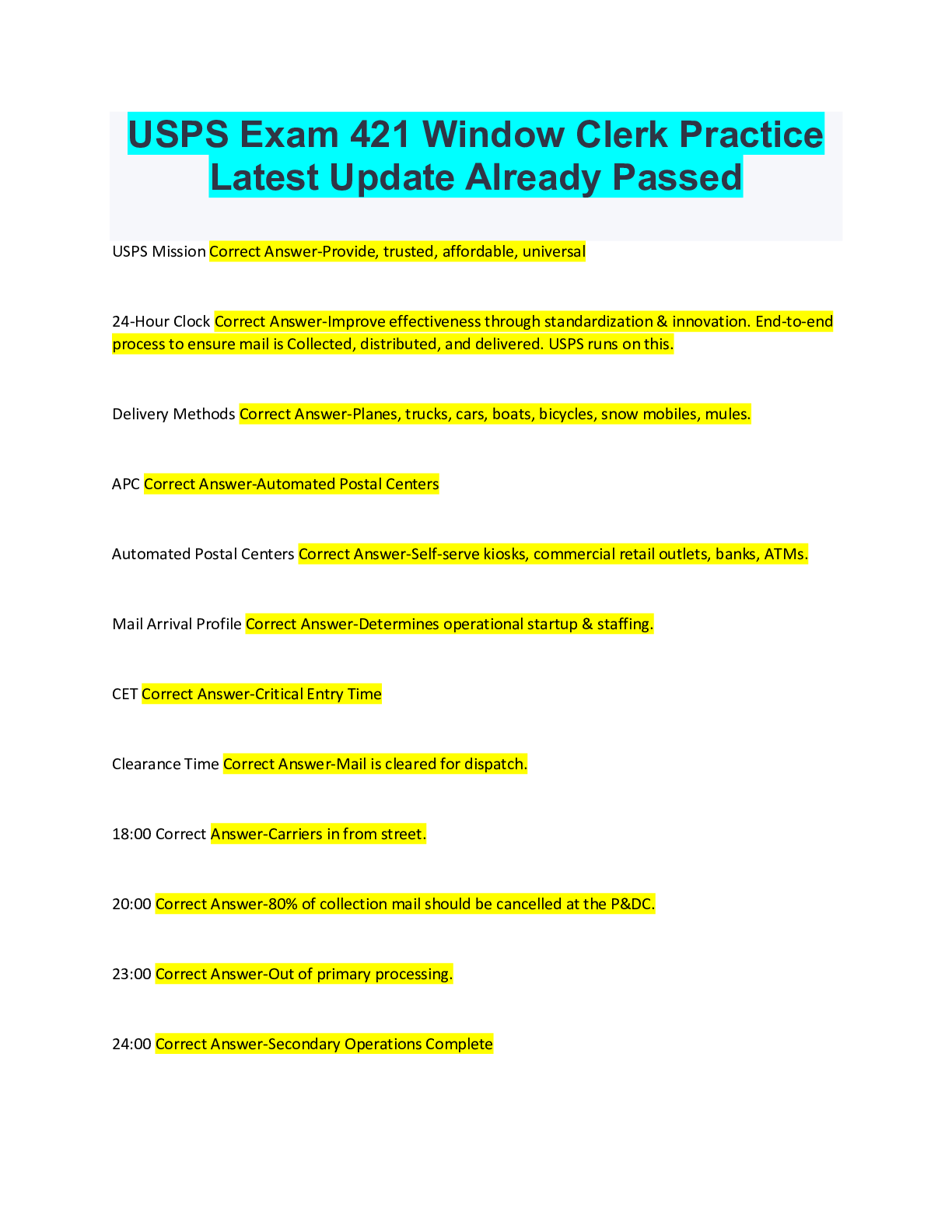


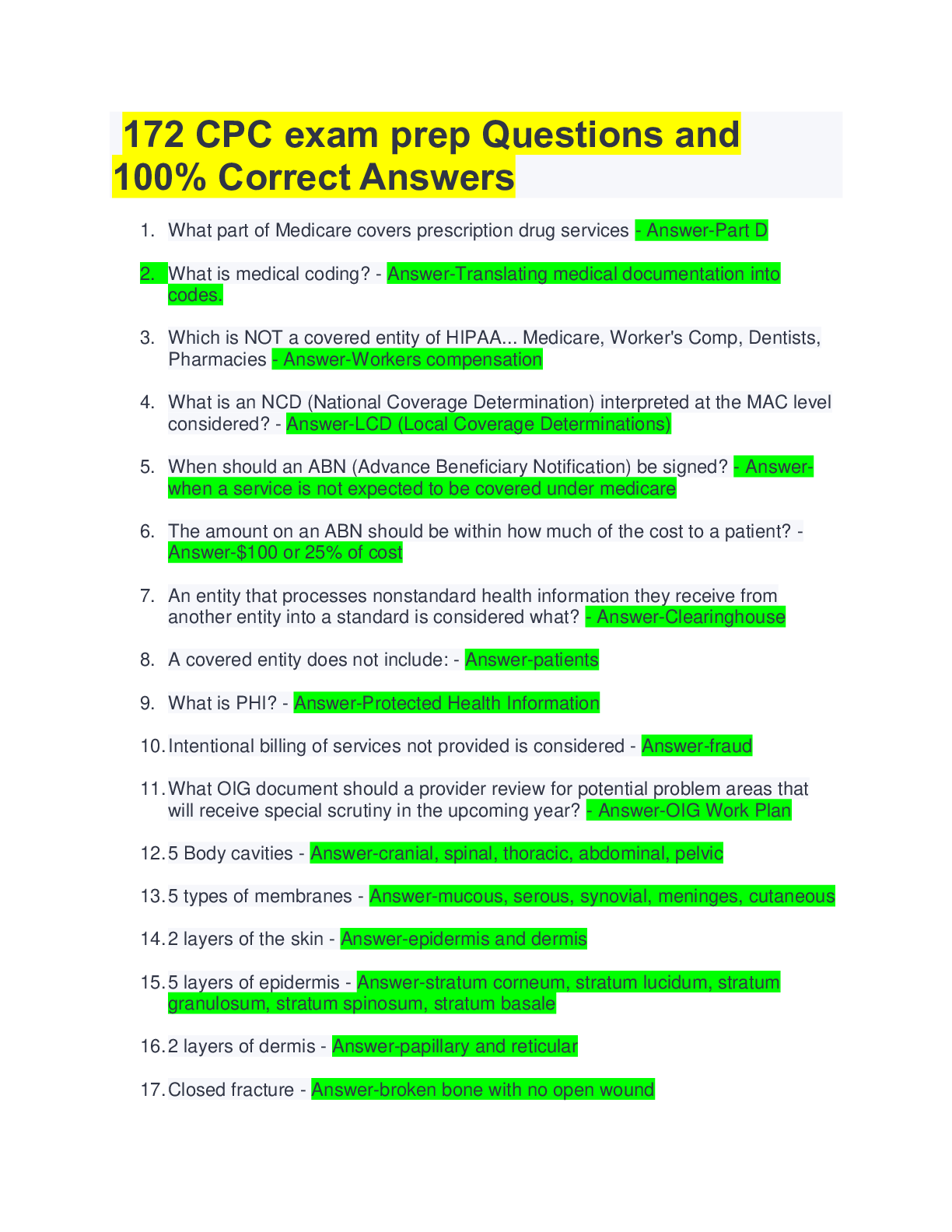

.png)

.png)
.png)
